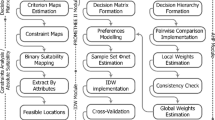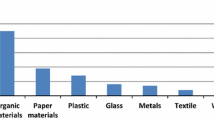Abstract
Sand and gravel are important raw materials which are needed for many civil engineering projects. Due to economic reasons, sand and gravel pits are frequently located in the periphery of metropolitan areas which are often subject to competing land-use interests. As a contribution to land-use conflict solving, the Analytic Hierarchy Process (AHP) is applied within a Geographic Information System (GIS) environment. Two AHP preference matrix scenario constellations are evaluated and their results are used to create a land-use conflict map.
Similar content being viewed by others
References
Araújo, C. & Macedo, A. (2002). Multicriteria geologic data analysis for mineral favourability mapping: application to a metal sulphide mineralized area, Ribeira valley metalogenic province, Brazil. Natural Resources Research, 11(1): 29–43
Bund für Naturschutz BfN (2001). BfN-Wissenschaftler unterstützen Geo-Tag der Artenvielfalt im Ruhrgebiet, Pressemitteilung 08.06, 2001. in German
Carver, S. (1991). Integrating multi-criteria evaluation with geographical systems. International Journal of Geographical Information Systems, 5: 321–339
Dai, F.C., Lee, C.F. & Zhang, X.H. (2001). GIS-based geo-environmental evaluation for urban land-use planning: a case study. Engineering Geology, 61: 257–271
Eastman, J.R., Jiang, H. & Toledano, J. (1998). Multi-criteria and multi-objective decision making for land allocation using GIS. In: Beinat, E., Nijkamp, P. (eds), Multicriteria Analysis for Land-Use Management, pp. 227–251. Kluwer Academic Publishers
Esri Inc. (2004). ArcGIS 9. ESRI Inc., Redlands, California
Malczewski, J. (1999). Spatial multicriteria decision analysis. In: Thill, J.C. (ed.), Spatial Multicriteria Decision Making and Analysis — A Geographic Information Sciences Approach, pp. 11–48. New York, N.Y, Ashgate
Marinoni, O. (2004). Implementation of the analytical hierarchy process with VBA in ArcGIS. Computers and Geosciences, 30(6): 637–646
Marinoni, O. (2005). A stochastic spatial decision support system based on PROMETHEE. International Journal of Geographical Information Science, 19(1): 51–68
Pereira, J.M.C. & Duckstein, L. (1993). A multiple criteria decision-making approach to GIS-based land suitability evaluation. International Journal of Geographical Information Systems, 7: 407–424
Saaty, T.L. (1977). A scaling method for priorities in hierarchical structures. Journal of Mathematical Psychology, 15: 231–281
Saaty, T.L. & Vargas, L.G. (1991). Prediction, Projection and Forecasting. Kluwer Academic Publishers, Dordrecht
Tkach, R.J. & Simonovic, S.P. (1997). A new approach to multi-criteria decision making in water resources. Journal of Geographic Information and Decision Analysis, 1: 25–44
Author information
Authors and Affiliations
Corresponding author
Additional information
Oswald Marinoni studied geology at the University of Mainz and the Technische Universität Berlin where he specialized in engineering geology and graduated in 1994. He was then research associate for the chair of engineering geology at the TU Berlin. From 1999 to 2001, he worked as a geotechnical consultant with focus on risk assessment in areas of former lignite mining. In 2000 he was awarded a PhD for his geostatistical research in the central area of Berlin. Since 2001, he is a member of the geo-resources and geo-hazards group of the Technische Universität Darmstadt. His main research interests are the regionalization of geo-data with the help of geostatistics, the application of GIS and the development of spatial decision support systems.
Andreas Hoppe studied in Bonn, Freiburg and Heidelberg where he earned a diploma in geology in 1975. His doctoral thesis and habilitation at the University of Freiburg dealt with the Precambrian of Brazil. From 1993 to 2000 he was director of the Geological Survey of Hesse. Since 2001 he holds a chair on Geo-Resources and Geo-Hazards at the Technische Universität Darmstadt.
Rights and permissions
About this article
Cite this article
Marinoni, O., Hoppe, A. Using the analytical hierarchy process to support sustainable use of geo-resources in metropolitan areas. J. Syst. Sci. Syst. Eng. 15, 154–164 (2006). https://doi.org/10.1007/s11518-006-5004-8
Issue Date:
DOI: https://doi.org/10.1007/s11518-006-5004-8




